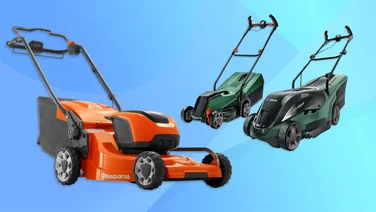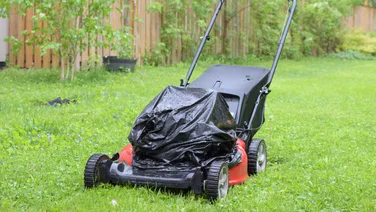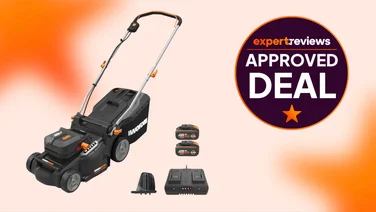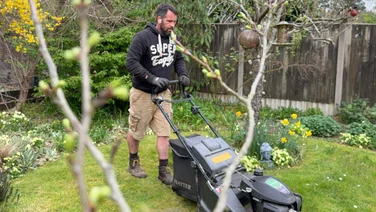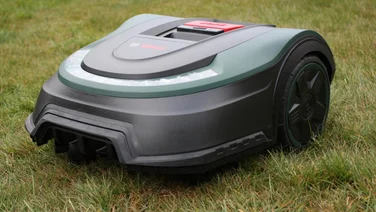To help us provide you with free impartial advice, we may earn a commission if you buy through links on our site. Learn more
- What is moss?
- What causes moss in lawns?
- How can you get rid of moss?
- When can you get rid of moss?
- How to get rid of moss by scarifying
- How to get rid of moss using chemical-free products
- How to get rid of moss using chemical moss killer
- How do you prevent moss from returning?
- How to get rid of mushrooms
- How to get rid of weeds

Working out how to get rid of moss from a lawn is an evergreen problem. Most of us have moss growing alongside the grass in our gardens, but too much of it means the grass has to compete for water and nutrients, and it can give your lawn a messy and uneven appearance.
Even the best cordless lawn mowers can only do so much to tackle these issues. But the good news is that it’s possible to get moss under control without enlisting a gardener or a specialist moss removal service – you just need to know how to tackle it.
From raking to chemical solutions, there are a number of tactics you can employ in the fight against moss. In this easy explainer, we’ll talk you through the causes of moss in lawns and the best ways to remove that moss while still protecting the rest of your turf.
What is moss?
Mosses are rootless non-flowering plants, ranging from the soft, springy kind you might find carpeting forest floors to the pesky stuff that clog your gutters and ruin driveways. There are even tropical varieties you might buy for use in terrariums. There are over 15,000 types of moss and they are extremely hardy – hence their invasion of your lawn.Moss provides a habitat for many species of small insects, making it important for biodiversity, but most of us don’t want it ruining the appearance of our garden. Plus, Cheryl Harper, managing director at Greensleeves Lawn Care, says it’s important to keep it under control for the health of your lawn. “If left to grow, moss can take up all the sunlight, water and nutrients in your lawn, stopping these vital elements from reaching your grass. Moss can spread rapidly, outcompeting grass and preventing it from growing.”
What causes moss in lawns?
There are myriad reasons for an excess of moss, from waterlogged grass or soil to too much shade, poor soil health, high foot traffic and even cutting grass too short – it is all too easy to fall foul of moss in your lawn.
READ NEXT: Best lawn mowers
How can you get rid of moss?
There are several ways to tackle problem moss and you may well need to employ more than one in order to be rid of it.
- Scarifying – Removing thatches of moss from the surface of the lawn using a scarifier machine or manually using a rake
- Non-chemical treatments – Topical treatments to feed the lawn that help keep moss to a minimum
- Chemical moss killer – There are two main types of chemical moss killer and they should be used with caution and sparingly, for both environmental reasons and to protect the remainder of the lawn
READ NEXT: Best robot lawn mowers
When can you get rid of moss?
This depends on the type of treatment you implement as you also need to give the lawn time to repair itself after the process. Scarifying and raking is best done in April and September, but not in between, as this is when the moss will be sporing and the treatment may just cause the problem to spread.
Other treatments can usually be employed between April and October, as long as the weather is fine. For best results, you should mow before performing any of these moss-killing methods.
READ NEXT: Best lawn mower for small gardens
How to get rid of moss by scarifying
For average and small lawns, this can be done by hand using a spring rake. Simply rake across the surface of the lawn, gathering moss and old grass until you can see soil in the affected areas. As this can be quite intense physical activity, larger lawns will be better served by employing a scarifier machine.
For mild moss problems scarifying alone may do the trick. However, as Cheryl Harper of Greensleeves Lawn Care suggests, it is still a good idea to perform scarification before going on to use a non-chemical or chemical moss killer: “Scarification thins out and removes surplus moss that has developed within the lawn. Removing much of the moss is vital as the grass needs space to grow and extreme layers of moss can limit the movement of water, air and fertiliser.”

If untreated, you can compost the removed moss, mixed with other materials. If treated, dispose of the moss as per the mosskiller manufacturer’s instructions.
How to get rid of moss using chemical-free products
Organic bacteria-based moss killer products claim to help eliminate moss, but some experts doubt their efficacy and, while they are certainly beneficial for stronger, healthier grass, you may unfortunately find that anything more serious than a low-level moss problem will require something stronger. If using these products, mow first and apply while temperatures are mild. Always follow the manufacturer’s instructions when applying and note that most of them will require mixing with water and spraying to become active.
If the treatment is successful, the moss will break down naturally, so you probably won’t need to perform a rake afterwards. You can mow the lawn again around ten days after the treatment, and sow grass seed in any bare patches as necessary.
READ NEXT: Best weed killers
How to get rid of moss using chemical moss killer
Chemical moss killer is the most efficient way of removing moss but it should be used sparingly and in a targeted manner during cool and damp periods. These chemical products typically use iron-based compounds – such as ferrous sulphate – to draw out moisture, causing the moss to dry out, blacken and die within hours. However, their synthetic makeup means they should be used carefully, and always according to manufacturers’ instructions.
Chemical moss products are usually sprayed on as a liquid. Some need to be applied directly to the moss alone, while other products also have a fertiliser to encourage healthy lawn growth, so should be applied to wider problem areas. After around two weeks, and once the moss has died, you will need to rake out and dispose of the chemically treated moss with care – treated moss can take up to six months to be safely composted, and may not be suitable for composting at all.
Once the moss has been removed you can reseed the bare patches and apply further lawn feed treatments.
How do you prevent moss from returning?
Essentially, the stronger and more robust your turf is, the less chance moss has to take advantage and populate your lawn. Consider the points below to encourage vigorous, lush growth that should help to keep moss at bay:
- Keep grass healthy with fertiliser and regular raking
- Keep your lawn well watered using a sprinkler system
- Aerate your lawn in the autumn by using a garden fork to make regular holes across the surface of your lawn
- Use grass seed by sprinkling it over any bare patches where moss has been successfully removed
- Do not cut grass too short – stick to the ‘one-third’ rule when mowing by setting the blades at a height that will only remove one third of the grass’s current height at a time
- “If shade is causing moss in your lawn, reduce the impact by cutting back overhanging plants or trees to allow more sunlight to the grass,” suggests Harper
How to get rid of mushrooms
Another common lawn invader you may encounter are mushrooms and toadstools. These spore-spreading fungi not only ruin the look of your lush lawn, but can be poisonous to humans and pets. Since identification is famously difficult, it’s best to avoid eating any mushrooms from your lawn. Mushrooms thrive on decaying organic matter and they like warm, wet conditions – so British weather often provides ideal growth conditions.

“There are no fungicides that will deal with mushrooms and toadstools,” says Harper. “The best way to stop their spread is to remove them by pulling them out of your lawn at the base as soon as possible. Don’t forget to wear gloves. Raking up leaves and other waste will create less of an opportunity to thrive too.”
READ NEXT: Best garden hoses
How to get rid of weeds
Weeds are another scourge on lawns that can be frustratingly difficult to eliminate, given how easily they can be brought back into your garden thanks to seeds from birds, bees and even the soles of shoes.
Harper has this advice: “Weeds are best treated when they are actively growing, typically between April and October. They can be removed by hand, which will get rid of them for the time being, but this can be a daunting task and may even exacerbate the problem.”
If your lawn has a serious ongoing weed problem it may be best to call in the professionals rather than turning to a commercial weed killer. “We use a special herbicide formulated with multiple active ingredients to target a broad range of weeds without causing harm to your grass,” Harper says. “Weed-killing products available in shops can cause your lawn more problems if not applied professionally.”

